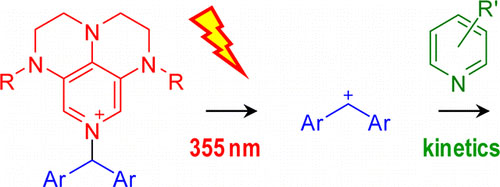Photogeneration of Benzhydryl Cations by Near-UV Laser Flash Photolysis of Pyridinium Salts
28-Nov-2012
J. Phys. Chem. A, 2012, 116, 8494-8499 published on 31.07.2012
J.Phys.Chem. A
Laser flash irradiation of substituted N-benzhydryl pyridinium salts yields benzhydryl cations (diarylcarbenium ions) and/or benzhydryl radicals (diarylmethyl radicals). The use of 3,4,5-triamino-substituted pyridines as photoleaving groups allowed us to employ the third harmonic of a Nd/YAG laser (355 nm) for the photogeneration of benzhydryl cations. In this way, benzhydryl cations can also be photogenerated in the presence of aromatic compounds and in solvents which are opaque at the wavelength of the quadrupled Nd/YAG laser (266 nm). To demonstrate the scope and limitations of this method, the rate constants for the bimolecular reactions of benzhydryl cations with several substituted pyridines were determined in acetonitrile and with water in acetone. The obtained data agree with results obtained by stopped-flow UV–vis spectroscopic measurements. The rate constants for the reaction of the 4,4′-bis[methyl(2,2,2-trifluoroethyl)amino]benzhydrylium ion with 4-(dimethylamino)pyridine were also determined in dimethyl sulfoxide, N,N-dimethylformamide, and acetone. From the second-order rate constants, we derived the nucleophilicity parameters N and sN for the substituted pyridines, as defined by the linear free energy relationship, log k2 = sN(N + E).



